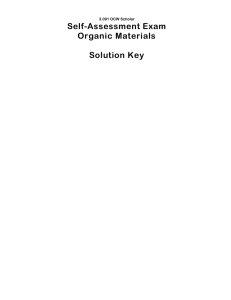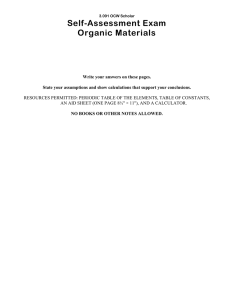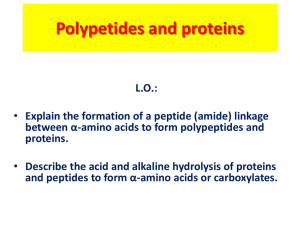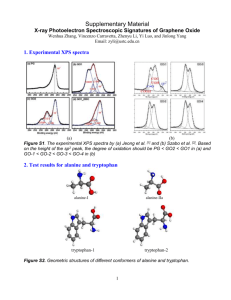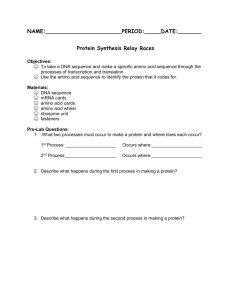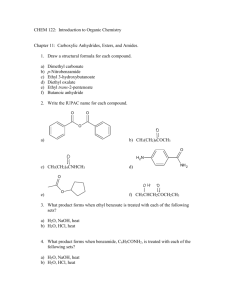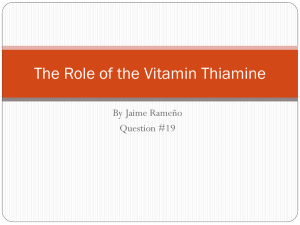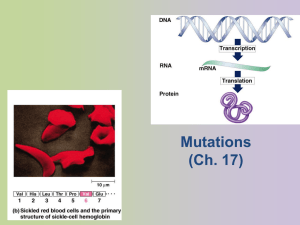MICROBIAL PRODUCTION OF AMINO
advertisement
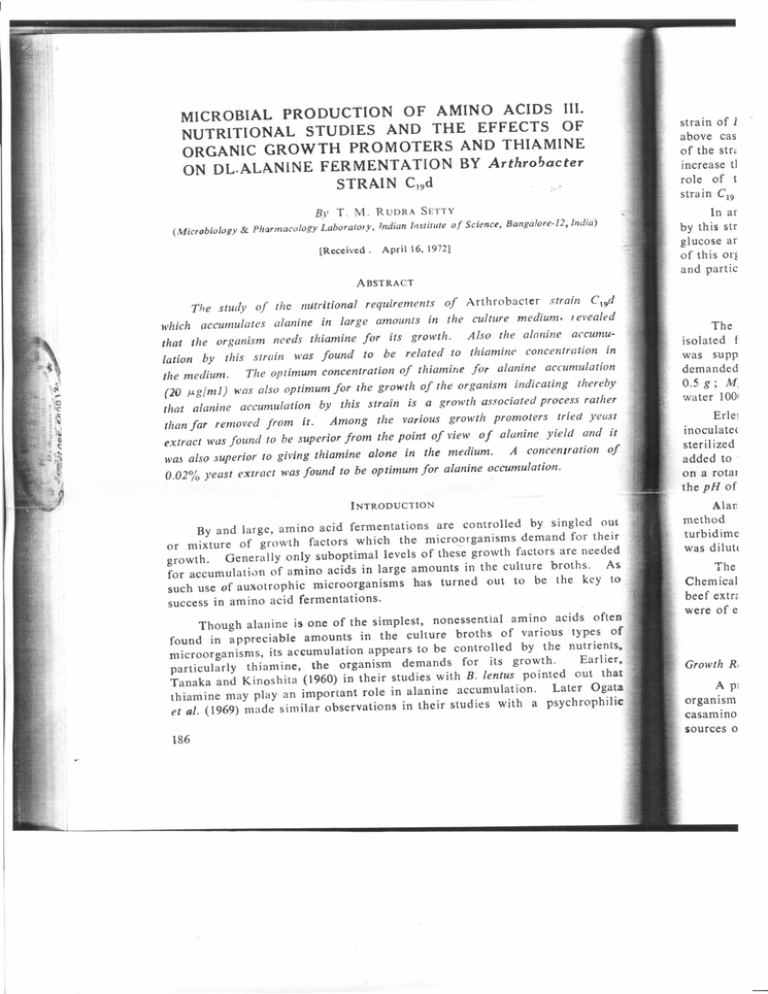
MICROBIAL PRODUCTION OF AMINO ACIDS Ill. NUTRITIONAL STUDIES AND THE EFFECTS OF ORGANIC GROWTH PROMOTERS AND THIAMINE ON DL.ALANINE FERMENTATION BY Arthrobqcter STRAIN CI9d By T. M. (Microbiology & Pharmacology Laboratory, [Received. RUDRA strain of 1 above cas of the str, increase tl role of t strain C19 In ar by this str glucose ar of th is or! and partie SETTY tndian Institute 0/ Science, Bangalore-l Zv lndia) April 16, 19721 ABSTRACT The study which that the accumulates the lation by this (20 tJ.g/mJ) alanine than far extract nutritional alanine organism the medium. that of needs strain requirements in large thiamine for was found The optimum amounts to its be concentration of in the growth. related Arthrobacter culture medium. 1 evealed A Iso the alanine accumu- to thiamine of thiamine for accumulation from by this it. Among was found to be superior from wa5 also superior to giving thiamine 0.02% yeast extract was found strain growth the point of view of in the medium. thereby process rather promoters alanine in accumulation indicating is a growth associated the various alone concentration alanine Was also optimum for the growth of the organism removed C'9d strain tried yeast yield and it A concentration of to be optimum for alanine occumulation. INTRODUCTION By and large, amino acid fermentations are controlled by singled out or mixture of growth factors which the micro~rganisms demand for their growth. Generally only suboptimal levels of these growth factors are needed for accumulation of amino acids in large amounts in the culture broths. As such use of auxotropb ic microorganisms has turned out to be the key to success in amino acid fermentations. Though alanine is one of the simplest, nonessential amino acids often found in appreciable amounts in tbe culture broths of various types of microorganisms, its accumulation appears to be controlled by the nutrients, particularly thiamine, the organism demands for its growth. Earlier, Tanaka and Kinoshita (1960) in their studies with B. lentus pointed out that thiamine may play an important role in alanine accumulation. Later Ogata et al. (\969) made similar observations in their studies with a psychrophilic 186 The isolated f was supp demanded 0.5 g; M. water 1001 Erie) inoculate: steril ized added to . on a rotai the pH of Alan method turbidime was dilute The Chemical beef extra were of e Growth R, A pI organism casamino sources 0 Effect of Thiamine on alanine fermentation 187 strain of Brevibacterium, accumulating alanine in the medium. In both the above cases, alanine accumulation was related to the thiamine requirement of the strain and suboptimal levels of thiamine in the medium, was found to increase the alanine accumulation. Our results also indicate the positive role of thiamine in the accumulation of alanine by this Arthrobacter stra in C19 d. In an earlier communication we have detailed the conditions required by this strain C19 d, for alanine production in a synthetic medium containing glucose and urea", This communication presents the nutritional requirements of this organism and the effects of some of the organic growth promoters and particularly the role of thiamine, on alanine production by this strain. MATERIALS AND METHODS The Arthrobacter strain C19 d used in the present investigation was isolated from soil, using glycine enrichment". The basal medium which was supplemented with organ ic grow th promoters as each experiment demanded, contained, glucose 75.0 g; urea 5.0 g; K2 HP04• 0.5 g; KH2 P04, 0.5 g; MgS047H20, 0.25 g; MnS04 H20 and FeS04 7H20, 0.01 g and distilled water 1000 ml, adjusted to p H 7.3. r Il r d .s o Erlenmeyer flasks (500 ml) containing 100 ml of the above medium were inoculated after ster ilization at 121°C for 20 min. Glucose was always sterilized separately at 116°C for 15 min and urea was filter sterilized and added to the medium at the time of inoculation. The flasks were incubated on a rotary shaker (250 r.p.m.) at room temp (24-28°C). During cultivation the pH of the medium was kept between 7 ~ 8. Alanine was evt irnated by paper chromatography according to the method described by Giri et at,", Bacterial growth was measured turbidimetrically with a Bausch & Lomb colorimeter. The culture broth was diluted twenty-fold and its optical density was measured at 540 m u , The vitamins used in the study were obtained from B.D.H. Laboratories, Chemicals Division, Bombay. The organic growth promoters like peptone, beef extract, yeast extract, nucleic acids (yeast), vitamin-free casamino acids were of either Difco or Oxoid preparations. RESULT Growth Requirements AND DISCUSSION of the Organism: A prel iminary identification of the growth factor requirements of the organism was carried out using organic growth promoters like vitamin-free easamino acids, synthetic vitamin mixture, nucleic acids and yeast extract as sources of amino acids, vitamins and purines and pyrimidines, respectively. f. 188 M. RUDRA SETTY The results of the experiments shown in Table I-A, revealed' that this organism could grow well wherever vitamin mixture either singly or in combinations of other growth promoters was supplied. It could grow equally well on yeast extract also. However, casamino acids and nucleic acids could not promote the growth either singly or in combination, since the increase in growth was not significant as compared to the- control. The fact that vitamin mixture alone could give as ..much growth as the one in which all the organic growth promoters were combined, was suggestive' of the essentiality of a particular vitamin or vitamins, for the growth of this' organism, So the vitamin requirement of this organism was studied by the vitamin exclusion technique on the lines followed by Dias and Bh it (1963), the results of which are shown in Table I-B, H is clear from the results of this experiment that the organism needs only thiamine for its growth. TABLE Growth "Grdwth Vitamin fattors flee added ----- Growth as 0.0. casamino 0.05 mixture. 0.17 Nucleic acids 0.06 VFCAA + Vit. mixture 0.17 VFCAA + Nucleic 0.05 Vitamin mixture nucleic Pepto 1-8 Vitamin VFCCA of Cl9 d 1 acids (VFCAA). nuclic acids + 0.17 Vitamins Growth excluded as 0.0. None 0.07 Pyridoxine 0.07 Thiamine 000 PABA 0.07 Nicotinic U.08 acid 0.08 Riboflavin Ca.panthothe 0.08 nate acid. + V it. mixture extrac to in I A & 8 Requirements I-A _________________ Effect + 0.08 Biotin 0.17 Folic acid Yeast extract 0.17 Vitamin None added 0.04 All Vitamin mixture: Pyridoxine thiamine, PABA, Nicotinic acid Riboflavin, Calcium Pantbotheoate Biotin, Folic acid, and Vit.BI2 growth-96 hr. 0.07 acid 0.08 En 0.00 Growth-S days Beef Effect of Thiamine Effect of organic growth promoters on alanine fermentation 189 on alanine production: organic growth promoters like peptone, The effect of various beef extract and. yeast extract on alanine production was then tested, with a view The results are presented in Table II. to increase the yield of alanine. TABLE II Effect of Organic Nutrient added Growth Levels of nutrient added% o OS Peptone 0.10 0.05 Beef extract 0.10 005 Peptone + Beef Extract 0.10 0.05 0.10 Factors on Alanine Growth Production in (0.0.) Alanine ---- by CJ9 d Incubation in hours 25 36 48 60 pH Growth Alanine pH Growth Alanine 8.2 0.12 8.2 0.19 0.80 8.2 0.25 1.2 8.2 0.21 1.20 8.2 0.33 2.0 8.0 0.31 1.50 7.0 6.46 2.7 pH Growth Alanine pH Growth Alanine 8.0 0.11 8.2 0.16 0.6 8.2 0.24 1.1 8.2 0.17 1.1 82 0.26 16 8.5 0.25 1.0 7.3 0.42 1.7 8.2 0.25 1.2 8.0 0.3 1.7 8.2 0.33 2.0 8.0 0.62 2.5 7.0 0.46 2.7 6.7 0.75 2.7 8.2 8.2 0.42 2.8 7.0 0.78 2.8 8.0 0.50 3.5 6.4 0.82 2.1 mglml 82 fl.17 neg 8.0 0.17 neg pH Growth Alanine pH Growth Alanine 8.2 0.17 pH Growth Alanine pH Growth Alanine 8.2 0.23 neg 8.2 0.23 neg 8.2 0.30 1.1 0.35 1.7 8.2 052 3.2 ----- =negligible , " 190 T. M. RUDRA SETTY Product formation was good with all the three growth promoters provided in the medium either singly or in combination. Without any growth factors, the organism accumulates only negligible amounts of alanine and the growth also will be scanty. Among the three growth> promoters exam ined, yeast extract was superior to other two from the point of view of growth as well as alanine formation. Combination of peptone and beef extract did not prove better than either peptone alone at 0.10% level or yeast extract at 0.05% level. However, growth was better with this combination than with peptone and beef extract individually and was in a way comparable with that of yeast extract at both levels. Since yeast extract was superior to other two growth promoters examined, various levels thereof were put to the test in order to arrive at the optimal concentration required for maximal product formation The results of the experiment are shown in table Il l. Lower levels of yeast extract Were found to be highly stimulatory and adequate for product formation; higher levels were conducive only to the growth of the organism rather than product formation. As can be seen from the table, yeast extract at 0.02% level was far superior and raised the yield of alanine to 5.6 mglml which is nearly 50 per cent more than the previous best yield (3.5 mg/m!). Effect oj thiamine on alanine accumulation by CI9 d : Since the organism needs thiamine for its growth, the levels of thiamine on alanine accumulation was examined. the results of the experiment. effect Table of va rious IV shows Growth of the organism as well as the alanine accumulation were found to be clr-se ly related to the concentrations of thiamine provided in the medium. Apart from this glutamic acid accumulation which used to be in negligible amounts, also was stimulated considerably by thiamine. It can be seen from Figure I that the thiamine concentrations upto ICJ}.J. gjml were stimulative for glutamic acid accumulation, whereas for alanine upto 20 M glml concentration was, in fact, required. Th is experiment was indicative of the optimum levels of thiamine needed for glutamic acid and alanine accumulation respectively. The yields of glutamic acid and alanine at their respective optimum levels of thiamine were raised to 3.5 mgjml and 7.6 mgjml respectively. Also the optimum level of thiamine needed for maximal alanine production was optimum for growth of the organism indicating that the product formation is essentially growth associated rather than far removed from it. The low values obtained for growth and amino acids (Table IV) in the treatment receiving 5 M gjml thiamine, up to 48 hr. growth, are due to frequent pH corrections made during that period as the pH tended to shift towards acid side. I Effect of Thiamine promote Effect of Yeast Extract on Alanine Production by Cud promoters Amount of view of ~ and beef vel or yea omb inat ion comparable superior to put to the .r maximal able Iff. added Nutrient added Yeast 0/0 Growth Incubation in hours (0.0. ) Alanine ( mg!m/) 48 72 96 0.005 pH Growth Alanine 8.2 0.41 3.6 82 0.41 3.8 8.2 0.43 2.5 0.01 pH Growth Alanine 8.2 0.44 4.6 8.0 0.54 4.8 6.0 0.55 3.3 0.02 pH Growth Alanine 8.2 0.41 5.6 7.3 0.54 5.6 7.0 0.61 3.6 0.05 pH Growth Alanine 8.2 0.42 2.8 8.2 0.75 3.5 8.0 0.75 4.0 extract ilatory and only to the an be seen raised the re than the Basal medium with glucose Boitin 2.5 p.g/ Ll inoculum of various IV shows E vere led I to It 7.5%, 1%. urea 0.5%. j '. o ALANINE ~ GROWTH • GLUTAMIC ACID _8 found in the be in can be gjm! were wine upto ment wa ; acid and nd alanine mgjml and needed for organism .ted rather and amino to 48 hr. od as the 191 rrr TABLE 'ithout a of alanine l> on alanine fermentation 017 E eO ~ ~5 ~ ~ 5" ~ ~ 3 •• ~ 2 z ctl oJ ~ -.r"O, %~~!~~~~~~~~~~~ FIG. 1 Effect of Thiamine on Alanine formation by CIS d . • Effect of Thaimine on Alanine Production Incubation Thiamine ad Ied I'lIlml 24 hrs -'-- - -=0 p-H ~00 Q~ E r-: E ••. -.I>O:lCO. :;;:5 (3E pH tv Time 72 hrs -'-- -=0' \0 by C19d 48 hrs -. - IV TABLE . -. E e~. c ••. -. O~ :;;:8 r--: E .- -=8 PH I>O:lCO ~ 00 O~ OE 96 hrs -e-, -'-- E E -. ';0I):l1>O :;;:5 r- - -"----, -=::;·s PH ~00 ••.• C~ OE E .••'~:l1>O :;;:8 (55 7.30.14 Sf sr 8.20.22' 1.1 2:0 7.50.24 I.J 2.6 6.4 0.251.5 3 7.0 0.15 SI Sl 8.2 0.22 1.4 L5 8.2 0.27 2.1 2.5 8.2. 0.27 5 7.3 0.05 Nil 0.5 8.0 028 Nil 0.7 8.2 0.35 2.5 2.0 7.9' 0.42 3.1 ..., 2.7 2.5 3: 3.4 1.3 ~ § :00 > 10 7.6 15 0.19 S1 1.7 8.2 760.19 Sl 1.5 8.20.303.02.6 7.90.385.6 20 7.6022 SI 1.9 8.20.353.22.5 7.90.477.62.1 25 6.7 0.15 SI SI 8.2 1.1.26 1.1 1.7 8.2 030 20 0.8 8.2 30 7.0 0.17 SI SI 8.2 0.27 I.J 1.6 8.2 0.31 18 O.R 40 6.7 0.17 SI SI 8,2 025 1.1 1.6 8.2 027 2.5 0.7 Ba~al medium 0.28 2.6 with glucose 3.5 8.0 0.37 10.0%, urea 0.75%. 4.6 inoculum 3.5 8.0 :2.3 0.46 4.0 3.0 C/.l 7.90.485.4 2.3 >< 7.90.556.4 2.1 0.32 2.3 0.7 8.2,0.32 2.1 0.7 8.5 2.5 0.7 0.28 10% h ~ !l":-'?'~ o-j o-jCllW;o ., o .,°oc ;3;gF~ !lll::"'ro .,.. w ••••• - ~., ..., '" --' 0.1 UQ o - 3:: c - -.. !"" o ~':;" _. ::l 0.' - ()O 0 ; V) S :::. S g ....• o ~. _0·CIl t.::- __ "0 0'-"00 ..., ...., 0 :::.& ~ s S _::roo t:: ==1 0 •....• !::. ~ a ~ I-+)~;';:r!ri ::l _. V> "0 o "'0.~"O0 ~ \) ~. g ;:; ~ ~::l 0.0.- ::::s ':0_ '" _ _ .,., m Dffect of Thiumihe 193 on alanine fermentation Stimulatory effects of thiamine on glutamic acid accumulation has been reported by Takahashi et al. (1965). Their organism, a Corynebacterium spp. responded to thiamine upto 10 fJ.. gjl. However, the difference in amounts of thiamine needed for maximum accumulation of glutamic acid by their strain and CI9 d is quite wide. Besides the optimum amounts of thiamine needed for alanine accumulation by the latter strain (20 fJ.. g/ml) is rather high as compared to that (I fJ.. g/ml) reported by Ogata et al. (1969). Higher levels of thaimine above 20 fJ.. g/ml, however reduced the yields of alanine markedly (Table IV) though growth was only slightly affected and the pH remained at optimum indicating the probable role of thiamine in alanine accumulation. ~ o o .aa u o ~ ACKNOWLEDGEMENTS I thank Prof. J. V. Bhat for his guidance in the critically going through the manuscript. I thank Commission for the award of the fellowship. work and University also for Grants REFERENCES "'I ~ o 1. Dias. F. F. and Bhat , J. V. 2. Giri. K. V., Radhakrishnan, and Vaidyanathan. C S. o o Indian J. Microbio!., J. Indian A. N. Ibid., 1966,48. No.4, 142. 3. Mullakhanbhai, Ogata, K., Kato, N., Osurn i, M. and Tochikura, T. Agric, - 5. Rudra Setty, T. M. and Bhat, J. V. J. Indian Inst . Sci., 1969.51, No.3, 6. Scott, T. A. and Melvin. E. H. A·nal. Chem., 1953, 25, 1656. a:::l 7. Somogyi, J, Bioi. Chem., 1926. 70,607. 8. Takahashi, J., Kobayashi. K , Imada, Y. and Yamada, K. Appl, 9. Tanaka, Nippon Nogeikagaku o U ;:l CO ..c ~ M. K. and Kinoshita, S. V. Sci., 1953, 35, 145 4. 4) II> M. F. and Bhal,1. u«. 1963,3, 127. & Bioi. Chern, 1969,33, No.5, 711. 357. Microbiol , 1965, 13, No.1. Kaishi, 1960, 34, 600.
